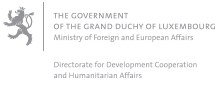- Home
- Preface
- European Year for Development
- COP21 and the Paris Agreement
- I. Luxembourg’s official development assistance in 2015
- II. Cooperation with the main partner countries
- III. Regional cooperation and cooperation with other countries
- IV. Multilateral cooperation
- V. European Union
- VI. Cooperation with non-governmental development organisations
- VII. Humanitarian action
- VIII. Programme support
- IX. Development education and awareness raising
- X. Inclusive finance
- XI. Evaluation
- XII. Report on the progress of the work of the Interministerial Committee for Development Cooperation
- Appendices
VII. Humanitarian action

Turkey - Turkish Red Cross factory where the 80 family tents were made which Luxembourg, via the Luxembourg Red Cross, provided to Syrian refugees
Prevention and resilience
Following the lead of the “Hyogo Action Framework”, which Luxembourg signed in 2005, as well as its successor, the “Sendai Framework for Disaster Risk Reduction 2015-2030” adopted in March 2015, the MFEA allocates 5% of its humanitarian action budget to financing activities in the field of prevention, resilience and disaster risk reduction. In line with this approach, the Ministry supports its humanitarian partners in implementing preventative measures such as initiatives to strengthen local capacities, risk evaluation, monitoring systems, early warning systems and the prepositioning of emergency items. The Ministry also encourages its partners to protect the environment and to integrate climate change adaptation strategies into their humanitarian projects. Prevention and resilience make up the third pillar of Luxembourg humanitarian action, both upstream and downstream of the emergency and transition stages.
In the field of prevention, the Ministry has primarily co-financed risk-reduction projects in Bangladesh. With the Ministry’s support, Friendship International Luxembourg drew up national guidelines for rural accommodation in areas especially prone to natural disasters. Furthermore, the NGO implemented community-based risk-reduction programmes which aim to reduce the vulnerability to disasters by strengthening community resilience and including the community in identifying, analysing, monitoring and assessing risks.
Other countries in eastern and southern Asia are also affected by recurring natural disasters. The Ministry has thus continued its support to the Aide à l’Enfance de l’Inde project with the aim of increasing community resilience in the face of recurring droughts in twenty-five villages in Maharashtra in India. Handicap International Luxembourg has received support to carry out a project to strengthen the health sector’s and communities’ preparation and capacity to respond to disasters which caused a huge number of deaths and injuries in the Katmandu valley in Nepal. Fondation Caritas Luxembourg also received support for a project in Laos that aims to analyse and reduce systematically the causes of natural and man-made disasters by mobilising local resources with the strong participation of individuals at the heart of the community.
The Ministry also supported prevention projects in the Sahel. The Bureau for Crisis Prevention and Recovery (BCPR) of the UNDP received a contribution from Luxembourg to its programme to strengthen the response capacities for rehabilitation and reconstruction in Niger, Burkina Faso and Cabo Verde.
In terms of prevention in a post-conflict context, the Ministry contributed to a Handicap International Luxembourg project carried out in Mali. Apart from reducing the immediate and long-term threat of conventional weapons and explosive devices improvised by the civil population, the aim of this project was to contribute to reducing risk factors and the impact of armed violence by strengthening the capacities of the authorities concerned and the local communities affected.
Sendai Framework for Disaster Risk Reduction 2015-2030
The Sendai Framework for Disaster Risk Reduction was adopted by 187 countries (including Luxembourg) on 18 March 2015 at the 3rd World Conference on Disaster Risk Reduction in Sendai (Japan). Adopting a multi-risk, multi-sector approach, the Sendai Framework highlights the importance of strengthening resilience and disaster risk reduction activities. In this context, the text recognises disaster risk reduction as essential in the context of sustainable development and an important first step in the post-2015 negotiations. The Sendai Framework follows on from the Hyogo Action Framework (HAF) and is a new voluntary, non-binding framework which aims to guide international and national efforts to reduce disaster risks from 2015 to 2030. Its scope is precisely defined and relates both to natural risks and man-made risks.

